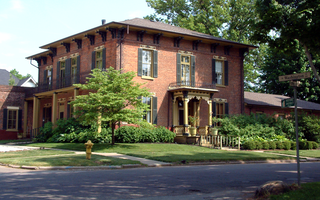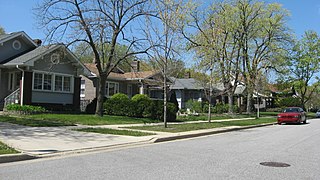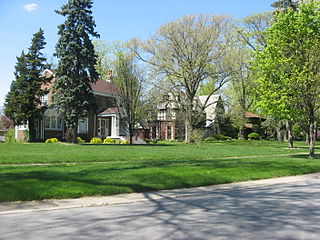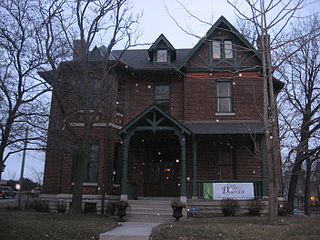
The Williams–Woodland Park Local Historic District was established in 1985 and is a national historic district located at Fort Wayne, Indiana. The district encompasses 287 contributing buildings in a predominantly residential section of Fort Wayne located approximately one mile south of downtown. The area was developed from about 1875 to 1940, and includes notable examples of Colonial Revival, Prairie School, and Queen Anne style residential architecture.

Brookview–Irvington Park Historic District is a national historic district located at Fort Wayne, Indiana. The district encompasses 423 contributing buildings and 1 contributing site in a predominantly residential section of Fort Wayne. The area was developed from about 1906 to 1965, and includes notable examples of Colonial Revival, Tudor Revival, and Bungalow / American Craftsman style residential architecture. A section of the neighborhood was platted and designed by noted landscape architect Arthur Asahel Shurcliff.

Cannelton Historic District is a national historic district located at Cannelton, Perry County, Indiana. The district encompasses 178 contributing buildings, 42 contributing structures, and 2 contributing objects in the central business district and surrounding residential and industrial areas of Cannelton. The area developed between 1837 and 1936, and includes notable examples of Gothic Revival, Late Victorian, and Bungalow / American Craftsman style architecture. A number of the buildings are constructed of native sandstone. Notable buildings include the National Historic Landmark Indiana Cotton Mill (1849-1850), St. Michael's Church (1859), F. H. Clemens Store, Cannelton Sewer Pipe Company, Josie Nicolay House, Myers Grade School / The Free School (1868), Jacob Heck Building (1882), Perry County Courthouse (1896-1897), and the separately listed St. Luke's Episcopal Church.

Bristol-Washington Township School, also known as Bristol High School, is a historic school building located at Bristol, Elkhart County, Indiana. The original section was built in 1903–1904, with additions made in 1923, 1925, and 1949. The original building is a two-story, Colonial Revival style brick and limestone building on a raised basement. The original building measures 61 feet by 61 feet. The building houses the Elkhart County Historical Museum.

Beardsley Avenue Historic District is a national historic district located at Elkhart, Elkhart County, Indiana. The district encompasses 41 contributing buildings, 3 contributing sites, 2 contributing structures, and 2 contributing objects in a predominantly residential section of Elkhart. It was developed after 1848, and includes residences in a number of architectural styles including Prairie School and Beaux Arts. Located in the district are the separately listed Dr. Havilah Beardsley House and Ruthmere Mansion. Other notable contributing resources are Island Park, Beardsley Park, the Main Street Memorial Bridge, St. Paul's Methodist Church, and the Best House.

Elkhart Downtown Commercial Historic District is a national historic district located at Elkhart, Elkhart County, Indiana. The district encompasses 59 contributing buildings in the central business district of Elkhart. It was developed between about 1868 and 1930, and includes notable examples of Italianate, Queen Anne, and Classical Revival style architecture. Located in the district are the separately listed Green Block, Lerner Theatre, and Young Women's Christian Association. Other notable buildings include the Cornish Block, Franklin Street Station (1895), Menges Building (1908), former Post Office (1905), Midwest Museum of Modern Art (1922), Elkhart Water Company, Masonic Temple, Rowe Block (1900), and Dreves Building.

State Street–Division Street Historic District is a national historic district located at Elkhart, Elkhart County, Indiana. The district encompasses 109 contributing buildings and two contributing structures in a predominantly residential section of Elkhart. It was developed between about 1868 and 1930, and includes notable examples of Italianate and Queen Anne-style architecture.

Downtown Nappanee Historic District is a national historic district located at Nappanee, Elkhart County, Indiana. The district encompasses 26 contributing buildings in the central business district of Nappanee. It was developed between about 1874 and 1939, and includes notable examples of Italianate and Classical Revival style architecture. Notable buildings include the Bechtel Building (1888), U.S. Post Office, Dietrich Block, Kaufman's Department Store (1902), First National Bank, Yoder's Garage, B&O Depot, Hartman Brothers Building, and Farmers and Traders Bank (1915).

The Georgetown Historic District is a national historic district located in Georgetown, Floyd County, Indiana. The district includes 163 contributing buildings, one contributing site, and three contributing structures in the central business district and surrounding residential sections of Georgetown.

Brady Street Historic District is a national historic district in Attica, Fountain County, Indiana. The district encompasses 108 contributing buildings, 9 contributing structures, and 4 contributing objects in a predominantly residential section of Attica. It developed between about 1840 and 1930, and includes notable examples of Greek Revival, Gothic Revival, and Italian Villa style architecture. Notable contributing buildings include the Carnegie library (1904), Schlosser House (1840s), Catholic Church (1891) and rectory (1895), McClaflin House (1904), and Greenwood House (1877).

Covington Residential Historic District is a national historic district located at Covington, Fountain County, Indiana. The district encompasses 109 contributing buildings in a predominantly residential section of Covington. It developed between about 1830 and 1958, and includes notable examples of Gothic Revival, Federal, Greek Revival, Italianate, Queen Anne, and Colonial Revival style architecture. Located in the district are the separately listed Carnegie Library of Covington, Fountain County Clerk's Building, and William C.B. Sewell House. Other notable contributing buildings include the Senator Daniel W. Voorhees House, Ward House, Kid & Mary DeHaven House (1880), Bisland House (1910), Spinning House, Mayer House (1907), Johnson House, Ristine-Savage House (1852), J. D. Fine Boggs House (1923-1924, Livengood House, Enos H. Nebeker House, Hamilton-Reed House, Covington Methodist Church, Clark House, and Allen-Cates House.

Metamora Historic District is a national historic district located at Metamora, Franklin County, Indiana. The district encompasses 115 contributing buildings and 10 contributing structures in the central business district and surrounding residential sections of the village of Metamora. It developed between about 1838 and 1923, and includes notable examples of Italianate, Gothic Revival, and Greek Revival style architecture. Located in the district is the Duck Creek Aqueduct. Notable contributing buildings include the Odd Fellows Building (1853), Gordon Hall Building, Jonathan Banes House, Metamora Masonic Hall, Martindale House (1838), Metamora Christian Church (1871), Redmen Hall Building, and Farmers Bank of Metamora (1923).

Forest–Moraine Residential Historic District is a national historic district located at Hammond, Lake County, Indiana. The district encompasses 108 contributing buildings in an exclusively residential section of Hammond. It developed between about 1913 and 1950, and includes notable example of Renaissance Revival, Colonial Revival, Tudor Revival, and English Cottage style residential architecture.

Forest–Southview Residential Historic District is a national historic district located at Hammond, Lake County, Indiana. The district encompasses 39 contributing buildings and 1 contributing site in an exclusively residential section of Hammond. It developed between about 1912 and 1949, and includes notable example of Renaissance Revival, Colonial Revival, Tudor Revival, and Bungalow / American Craftsman styles of residential architecture.

Old Greencastle Historic District is a national historic district in Greencastle, Putnam County, Indiana. The district encompasses 79 contributing buildings in a predominantly residential section of Greencastle. The district developed between about 1826 and 1961 and includes notable examples of Federal, Greek Revival, Italianate, Stick Style, Prairie School, and Bungalow / American Craftsman-style architecture. Notable buildings include the Davidson House and Gillespie-Lynch House (1830).

Winchester Residential Historic District is a national historic district located at Winchester, Randolph County, Indiana. The district encompasses 142 contributing buildings, 1 contributing site, and 1 contributing structure in a predominantly residential section of Winchester. The district developed between about 1837 and 1950 and includes notable examples of Greek Revival, Italianate, Romanesque Revival, Colonial Revival, Prairie School, and Classical Revival style architecture. Notable buildings include the First Presbyterian Church of Winchester (1903), Winchester Friends Church (1897), First United Methodist Church (1900), Main Street Christian Church (1912), First Church of the Nazarene (1929), Carey Goodrich House (1858), Kizer-Marsh House, and W.E. Miller House (1910).

Irvington Terrace Historic District is a national historic district located at Indianapolis, Indiana. It encompasses 578 contributing buildings and 9 contributing sites in a planned residential section of Indianapolis. The district developed between about 1895 and 1959, and includes representative examples of Tudor Revival, Colonial Revival, and Bungalow / American Craftsman style residential architecture.

St. Joseph Neighborhood Historic District is a national historic district located at Indianapolis, Indiana. The district encompasses 57 contributing buildings in a predominantly residential section of Indianapolis. It was developed between about 1855 and 1930, and include representative examples of Italianate and Queen Anne style architecture. Located in the district are the separately listed Bals-Wocher House, William Buschmann Block, Delaware Court, Pearson Terrace, and The Spink. Other notable buildings include the Christian Place complex, Fishback-Vonnegut-New House, Henry Hilker House, Apollo-Aurora Rowhouses, Israel Traub Store, and Lorenzo Moody House.

Holy Rosary–Danish Church Historic District, also known as Fletcher Place II, is a national historic district located at Indianapolis, Indiana. The district encompasses 183 contributing buildings in a predominantly residential section located in the central business district of Indianapolis. It was developed between about 1875 and 1930, and include representative examples of Italianate, Gothic Revival, Tudor Revival, and Renaissance Revival style architecture. Located in the district is the separately listed Horace Mann Public School No. 13. Other notable buildings include the John Kring House, Trinity Danish Evangelical Lutheran Church (1872), John Wands House (1857), Henry Homburg House, Samuel Keely House, Maria Wuensch Cottage, and Holy Rosary Catholic Church (1911-1925).

Shortridge–Meridian Street Apartments Historic District is a national historic district located at Indianapolis, Indiana. The district encompasses 136 contributing buildings in a predominantly residential section of Indianapolis. It was developed between about 1900 and 1951, and includes representative examples of Colonial Revival, Classical Revival, Late Gothic Revival, Mission Revival, Renaissance Revival, Bungalow / American Craftsman, and Art Deco style architecture. Located in the district is the separately listed Shortridge High School. Other notable buildings include the Vernon Court Apartments (1928), Fronenac Apartments (1951), Biltmore Apartments (1927), Meridian Apartments (1929), New Yorker Apartments (1917), Howland Manor (1929), Powell-Evans House (1911), Harms House (1906), Dorchester Apartments (1921), and Martin Manor Apartments (1916).
























